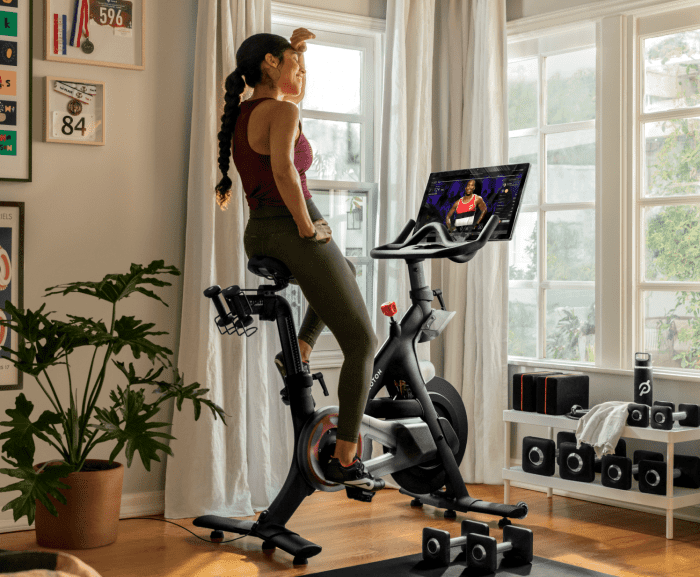Digital Transformation in Home Fitness

We’re at a point in existence where highly-connected technologies have seeded themselves into everything we do – of the many areas where apps and digital solutions have become commonplace, home fitness is a shining example of digital transformation. Building on solutions learned from previous decades of product performance, today’s solutions have more appeal and features than ever before.
The market has been keen on home fitness solutions for quite some time but use has soared recently because of not only the pandemic, but many other factors as well. To understand where this trend is going, we’re going to start by quickly looking at the history of home fitness and early products. From there, we’ll look at the effects of digital transformation on today’s most popular solutions then follow up by discussing what we’ve learned and what the future will hold.
A brief look back on the evolution of home fitness
The idea of home fitness has been around long before the coin was termed. We haven’t always known exactly how the body works but there has been an understanding that work (i.e., labor) and movement makes you strong. Even though Susruta of India and Hippocrates of Greece first began prescribing exercise in ancient times, this idea didn’t become widespread, especially in Western cultures, until thousands of years later in the 20th century. Eventually, gyms began to evolve to accommodate the average person and activities that were formally viewed as exclusive to athletes were more widely adopted in the modern world.

The 1980s were when things would start to take off. Though the first treadmill was built and released with some success in the 1960s, the general state of advertising in the 1980s along with the rise of the TV commercial, was a massive contributor to home fitness. Igniting this trend was none other than the Total Gym, thanks to endorsing by Chuck Norris and Christie Brinkley beginning in 1980.
Home gyms, mechanical cardio equipment, rowing machines, workout routines on VHS, and tons of gimmicky junk began to emerge on TV and throughout stores. The craze experienced peaks and valleys throughout the years, typically surging when new, more digital fitness solutions would emerge. Today, the digital component is now the most important element for the most successful solutions of this era. As we’ll see, the success of home fitness equipment is heavily dependent on its ability to motivate its user.

Your Partners in Digital Transformation
Sign up for our newsletter to learn more about how we can help with your digital transformation needs.
Oh no...This form doesn't exist. Head back to the manage forms page and select a different form.
The importance of fitness product digitization over time
Every piece of equipment had a certain appeal. The common denominator was that these devices were designed to fit in households and increase accessibility. Similarly, this was the driving force behind workout videos such as those from the legendary Richard Simmons. However, time would tell that bringing fitness into the home wasn’t quite enough to make a lasting impact for most buyers.
While some people would become dedicated, long-term users, it was discovered that most would ultimately stray for any number of reasons. Issues such as time management, accountability, improper exercise technique, environmental factors, and other reasons have all been cited over the years to explain why people stray from their routines as well as discredit home equipment. For example, bad form during exercise has been a substantial issue for many home fitness equipment users as this can lead to injury but more commonly, it makes exercise less effective and often results in feelings of discouragement. Injuries aside, the perception that little progress is being made is discouraging enough to drive many to quit.
This was one issue that early digital fitness solutions helped solve, beginning with cardio equipment. Preset configurations and quantifiable settings helped users to be able to better benchmark their workout routine. The addition of integrated timers also helped users see their performance during a routine.
Making workout performance more visible was a first step in helping better engage users as this allows people to measure and understand their performance. This was one of the first moves to introduce a core concept that would prove to be a major factor in sustaining a healthy lifestyle: motivation.
For some, the ability to better measure their performance (albeit, manually) with early digital fitness equipment made a difference as visible improvements positively impact user motivation. The first wearables with fitness applications would emerge in the 1980s through the Polar Watch but it wasn’t until some years into the era of smart devices and cloud computing that technology could inexpensively measure and record activity to provide evidence that supports just how important motivation is to an individual’s success.
The first product to successfully demonstrate how significant such capabilities are for fitness equipment was the Fitbit. Walking is one of the most accessible forms of effective exercise which Fitbit was able to position in the perfect light to drive early user adoption in 2009. Interestingly, it leverages a theory developed by Dr. Yoshiro Hatano who identified that “10,000 steps a day” is ideal for combating obesity, which is a benchmark still used today. While the benefits each user experience is different, the fact that it’s grown over the past decade to become a company that earns over a billion dollars and supports 30 million active users provides sufficient evidence to show that the formula is successful.
Around this time, other early examples of modern digital solutions designed to help with user health began to emerge like Lose It! which was one of the first apps on the Apple App Store. Like Fitbit, this product demonstrated that providing a comprehensive, visual tool for measuring and tracking performance would yield positive results from users. This notion was further supported by the success of early fitness trackers like Strava which is among one of the most popular fitness trackings apps today. Finally, the Wii Fit game for the Nintendo Wii which was released around the same time as the first iPhone gets a mention – interest and subsequent research revealed that people respond well to digital fitness, so much so that some adopted the system for clinical use.

Another idea that would ultimately work to augment the idea of making home fitness more engaging came about in 2012 after Peloton founder, John Foley, decided to pursue an effort to merge group workouts with technology because he felt a greater sense of reward from instructor-led sessions. The next year, Peloton’s Kickstarter campaign went viral, allowing the company to enter the market with the first iteration of their exercise bike that would eventually make their brand the gold standard by the end of the decade.
How digital transformation influenced the products of today
The main reason Peloton was able to lead the charge in digital transformation for the fitness equipment market isn’t because of some groundbreaking fitness technology, it’s because the “Peloton experience” has a major influence on motivation. Without going too far into a psychology lecture, tracking and measuring tools provide a framework for motivating people on all ends of the spectrum. Observable progress serves as an intrinsic motivator that helps both the smaller segment of users who truly enjoy working out as well as the many who view it as more of a chore. This data also has the power to serve as an extrinsic motivator when shared amongst peers, both for the sharer and the viewer. On-demand classes are excellent for a range of individuals, including those who are motivated by the dynamic of group environments, those who are impartial, and those who would typically avoid real-life group classes.
What’s important is here is how others would learn from Peloton’s example and emerging fitness tech, especially manufacturers who have been around for decades such as the following:
- Nordic Track’s unique, low-impact skiing machine was originally released in 1975, but wouldn’t make much of a splash in the market until the mid-late 1980s after appearing on infomercials. It would exchange hands a couple of times until 1998 when they were purchased by ICON Health & Fitness who would revitalize the brand by expanding offerings. The Nordic Track brand now offers a full range of treadmills, ellipticals, bikes, and strength equipment that all have embedded systems to run the company’s app.
- The Bowflex system came out in 1986 which a unique position as their resistance-based, strength-training equipment used a proprietary design that made their equipment light and affordable. Like many other home fitness brands, they went through especially tough times during the 2000s but later found that by expanding their offerings, a la Nordic Track, they were able to become profitable again and eventually invest in smart technology for their various pieces of equipment.
- Precor is another brand that surfaced in the 1980s, beginning with the first ergonomically sound rowing machine. They consistently experimented with technology throughout the years and later became one of the largest suppliers to health clubs and hotels. Precor’s consistent successes in serving the market allowed them to be one of the first to release a mobile app in 2013 – known as Preva, this app would grow alongside the equipment they offer today.
The reason these companies are noteworthy (and a few others who didn’t get a mention) is that many fitness equipment providers who didn’t care to or failed in executing an ongoing digital transformation effort had to find new ways to earn revenue. Each company above was able to navigate periods of less demand and market oversaturation by offering new styles of equipment then leveraging their brand name. This would only go so far as to boost revenue for most organizations until integrated apps become a standard component of digital fitness equipment. Along with the ever-growing capabilities of apps that offer some combination of tracking, analytics, networking, and on-demand classes, usage of various brands has revealed evidence for some “truths” about the market.

Various myths that pigeonholed app-driven digital fitness show to be untrue – all age groups are now using smart fitness equipment and it’s worked to compliment the traditional gym model, at least until COVID-19 struck. The health and fitness industry is now valued at around $4.2 trillion as substantial growth has been observed since 2017. Because of the 2020 pandemic, the market is growing even more as new entrants considered unicorns carve out space in the market. A great example of this is the product JAXJOX that BlueLabel helped design and develop as it has raised over $17 million over the last three years in funding alone. Even brands like Gatorade offer a digital fitness solution through their GX Sweat Patch that works in conjunction with its app to provide insights into hydration.
The reason this recent upheaval in the health and wellness realm shows us that this market is far beyond niche as it not only attracts a wide user demographic but continues to engage them. What’s different from other fitness fads that have come and gone since the 20th century are tech elements that offer everything from deep customization and gamification, both of which prove to increase engagement wherever they’re applied like in the gaming industry.
Fitness apps also have great potential for healthcare by linking with medical systems to provide PGHD (Patient-Generated Health Data) which can give providers deeper insights into an individual’s well-being. Certain apps that also work as aggregators for fitness products like Google Fit and Apple Fitness+ that act as hubs for many products on the market are in prime position to take matters even further in the near future.
What we can expect for the future of digital fitness
People have always been able to live healthily and even get in great shape without the aid of equipment or technology but it’s far more challenging. Fitness equipment aimed to solve this problem by providing more variety along with pie-in-the-sky advertising that promised results few would see but not necessarily because of faulty design. We now know that it’s because these products lacked mechanisms to instill motivation from multiple angles.
Interestingly, the fitness industry is helping reinforce the idea that certain motivators like being able to quantify improvements as well as both recursive gamification for self-reference and the ability to share with select networks are effective in driving users to stay engaged. These elements along with a variety of on-demand content add variety to routines which both helps prevent adaptive resistance for better growth results and keeps users engaged. Like all web-connected platforms, successful products will use this synergy to maintain a cycle that attracts and engages users with fresh experiences.
On-demand training through apps like Centr from Chris Hemsworth will continue to appear as such apps have proven to be highly effective at providing comprehensive knowledge that drives users to make and sustain lifestyle changes. Apps that embody a genuine message for change along with motivational components we’ve discussed will be set up for long-term success.
Of course, it’s natural to expect that this growing trend will at some point level off and even dip. Like any other emerging market – in this case, reemerging – it’s typical to see several innovative businesses enter the market around the same time with similar offerings which will serve to trim the fat as less successful companies either fail or are purchased by the competition. In time, certain high-profile performers will likely try to corner the market through the acquisition of other major brands on the market.
Apple is a great example of a potential disruptor to current trends in the market. Right now, they are helping develop technology to attract integrations through the Apple HealthKit which means an opportunity to learn from the data. As a company notorious for being a fast follower in any space they occupy, there is a high probability they will attempt to acquire significant players to expand their reach.

Paving the Way for Digital Transformation
We know how to bring business transforming ideas to life. Keep up to date with our newsletter.
Oh no...This form doesn't exist. Head back to the manage forms page and select a different form.We can build your digital fitness solution
The entire health and wellness industry is experiencing unprecedented growth meaning there is ample opportunity for businesses with attractive offerings and long-term growth strategies to secure a spot in the market. Adaptable businesses that can stay on top of trends and eventually pivot when the time comes will be in a good position to make an impact on generations to come. By applying lessons we’ve learned in motivation through technology, apps that exemplify this notion will be well-equipped to continually engage their user base.
The market knows what it wants, except when it doesn’t. Data strategy derived from testing user engagement with real people solidifies understanding of a dynamic problem set enabling us to fine-tune our output. Get in touch with us to learn how we can turn your idea into a successful product in the digital fitness market.






